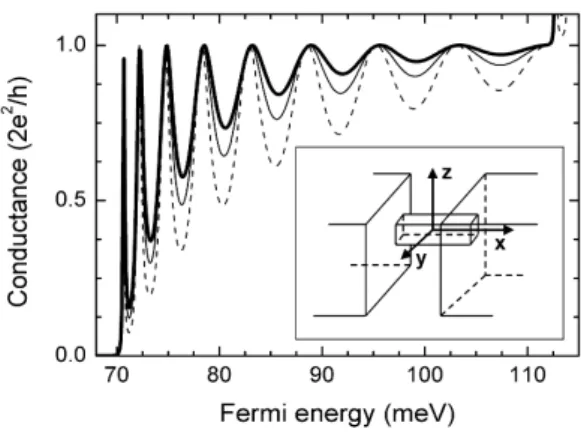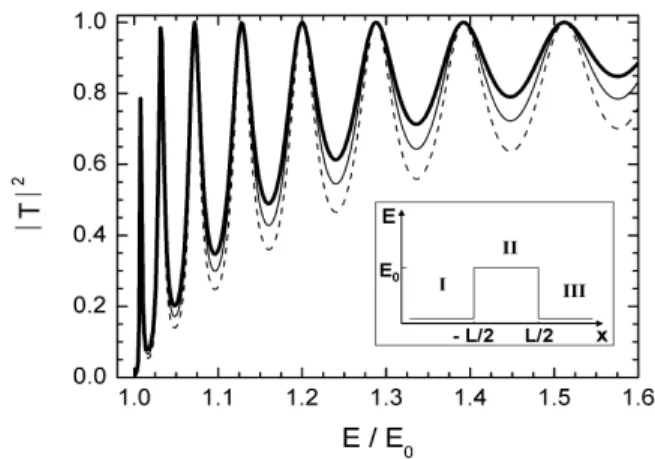910 Brazilian Journal of Physics, vol. 36, no. 3B, September, 2006
Effects of Effective Mass Discontinuity on the Conductance of Three-Dimensional Quantum Wires
Luis C. O. Dacal1 and Erasmo A. de Andrada e Silva2
1Instituto de Estudos Avanc¸ados - IEAv - CTA, C. P. 6044, 12228-001, S ˜ao Jos´e dos Campos - SP, Brazil 2Instituto Nacional de Pesquisas Espaciais - INPE, C. P. 515, 12201-970, S ˜ao Jos´e dos Campos - SP, Brazil
Received on 08 December, 2005
We calculate the conductance of three-dimensional semiconductor quantum wires considering different effec-tive masses in the contacts and in the channel. We show that, with respect to the case with equal masses in the channel and in the contacts, the amplitude of the conductance oscillations increases if the electron effective mass in the channel is larger and decreases if it is smaller than in the contacts. Effects on the density of probability are also shown. These effects of the effective mass discontinuity are explained in terms of kinetic confinement and transmission coefficient modulation.
Keywords: Quantum wire; Ballistic transport; Effective mass discontinuity
I. INTRODUCTION
Some years ago, intense efforts were devoted to the un-derstanding of the effective mass discontinuity effects on the electronic properties of semiconductor systems. A good ex-ample is the so calledkinetic confinement. When a semicon-ductor layer is grown between two others of a different mate-rial with a zero conduction band offset, there is no potential well to confine the electrons in the central layer. On the other hand, a kinetic energy variation is brought about by the ef-fective mass discontinuity and another kind of confinement can take place, namely, the kinetic confinement. It occurs when the heaviest effective mass is in the central layer, giv-ing rise to a kinetic energy reduction related to the transverse free motion. This kind of phenomenon was firstly exploited by Sasaki [1] in a proposal for an effective mass superlattice. After that, Kubisa and Zawadzki [2] investigated the effects of external magnetic fields on a ’kinetic well’. Since then, it has been investigated from the theoretical [3, 4] and experimental [5, 6] points of view. More recently, this interest was renewed through proposals for spintronic devices that employ different materials for contacts and channel [7, 8].
In this work, effects of the effective mass discontinuity are considered in a quantum wire system. We calculated the con-ductance for different ratios between the electronic mass in the contacts and in the channel. It is shown that this dis-continuity determines the conductance oscillation amplitude. It also affects the electronic density of probability inside the channel and we employed a simple one-dimensional model to discuss the transmission coefficient dependence on the mass ratio. The conductance calculation is analogous to that per-formed in a previous work [9] where we analyzed the effects of the system dimensionality.
II. MODEL
We consider a three-dimensional hard wall channel, or quantum wire, that connects the source and drain regions (see the inset in Fig. 1). The mode matching technique is employed to calculate the quantum ballistic conductance in the effective mass and envelope function frameworks. We use a basis set
FIG. 1: Conductance as a function of Fermi energy for a 100 nm long quantum wire with a 10x20nm2transverse section area. Three values forrm(mc/mw) are considered: 0.8 (dashed line), 1.0 (full line) and
1.2 (thick line).Inset: schematic representation of the system. The quantum wire is the central structure that connects the contacts. The axes orientation is also indicated.
with infinite quantum well solutions for the confined dimen-sions and plane waves for the propagating states. For more details, see our previous work [9] where the wave functions are presented and the calculation method is detailed.
Here, we take into account the difference between elec-tronic effective masses in the quantum wire (mw) and in the contacts (mc), whose ratio is given byrm (rm=mc/mw). In this work, we fixmw=0.067 (GaAs) and changemcthrough rm.
Luis C. O. Dacal and Erasmo A. de Andrada e Silva 911
FIG. 2: Density of probability inside the quantum wire for the system considered in Fig. 1. The samermvalues and correspondent lines are
used. The Fermi energy is 88.7 meV.
FIG. 3: Transmission coefficient as a function of Fermi energy for the one-dimensional analogue of the system considered on Fig. 1. The samermvalues and correspondent lines are used. Inset: schematic
representation of the one-dimensional system. Lcorresponds to the quantum wire length andE0corresponds to the conductance
thresh-old energy.
III. RESULTS AND DISCUSSION
In Fig. 1, we show the conductance as a function of the electronic Fermi energy for a 100 nm long quantum wire with a 10x20nm2transverse section area. We consider three values
forrm, namely, 0.8 (dashed line), 1.0 (full line) and 1.2 (thick line). As one can see, the conductance oscillation amplitude goes with the inverse ofrm. In other words, one can say that the conductance oscillations are reinforced when mw >mc. This effect is analogous to the one observed in our previous work [9] where narrow quantum wires and their correspon-dent strong confinement also increased the conductance oscil-lation amplitude. The difference is that, here, the electronic confinement is not controlled by the wire width, but by the ef-fective mass difference. Following this analogy, we may con-clude that the effective mass discontinuity represents an extra electron scattering mechanism at the entrance and exit of the quantum wire.
At the same time, it is important to notice that the
conduc-tance oscillations and plateaus are present even when rm is
greater than 1. This means that the qualitative aspects of the quantum wire conductance are preserved in this case.
In order to clarify the effects of effective mass variation on the electronic properties of the quantum wire, in Fig. 2, we show the density of probability as a function of the longitudi-nal quantum wire coordinate for the previous wire dimensions
and threerm values. We used the same legend of Fig. 1 and
88.7 meV for the Fermi energy, which corresponds to a con-ductance peak. It is shown that the charge localization is more pronounced for the leastrm value, namely 0.8 (dashed line). This can be understood as a kind of charge confinement due to mass discontinuity whenmwis greater thanmc. It is important to notice that the conductance threshold is not affected byrm
due to the constantmw value. Moreover, the oscillatory
be-havior of the density of probability is weakened but preserved whenrmis greater than 1.
The quantum wire can be thought as a Fabry-P´erot like os-cillator [9], what give us an alternative approach to explain
therminfluence on the wire conductance. By using a simple
one-dimensional model, an analytical expression for the trans-mission coefficient with explicit dependence on thermfactor can be obtained which shows the origins of the oscillation am-plitude variation. This model is schematically represented on
the inset of Fig. 3, whereLcorresponds to the quantum wire
length. The system is divided into three regions. I andIII
represent the contacts andIIcorresponds to the wire itself. In this last region, there is an energy barrier,E0, that represents the conductance threshold. We considered plane waves in the three regions and imposed wave function and probability flux continuity at the interfaces. The energy conservation was also considered and the expression for the transmission probability is written as:
|T|2= (2.rm.KI.KII)2
sin2(K
II.L).(rm2.KII2+KI2)2+cos2(KII.L).(2.rm.KI.KII)2
(1)
func-912 Brazilian Journal of Physics, vol. 36, no. 3B, September, 2006
tion of the Fermi energy for a system equivalent to that one considered on Fig. 1, what meansL= 100 nm andE0= 70.15 meV. As expected, it reproduces the conductance dependence onrm. This approach allows us to say that the effective mass variation has a significant effect on the transmission and re-flection coefficients of the system. rm values lower than 1 (mw>mc) reinforce these coefficients oscillations.
IV. CONCLUSIONS
We showed that the conductance of semiconductor quan-tum wires is strongly affected by the effective mass disconti-nuity when the contacts and the channel are made of different materials. We employed the mode matching technique in the effective mass and envelope function frameworks to calculate
the conductance in the ballistic regime. Our results show that the conductance oscillations amplitude is increased when the electronic mass in the wire is greater than that in the contacts. The same behavior is observed for the density of probability and the transmission coefficient, which was obtained through a simplified one-dimensional model.
We hope that our results may help to understand future ex-perimental data on transport properties of systems composed by different materials.
Acknowledgments
This work was supported by the Brazilian agencies FAPESP, CNPq and FUNCATE.
[1] Akio Sasaki, Phys. Rev. B30, 7016 (1984).
[2] M. Kubisa and W. Zawadzki, Semicond. Sci. Technol.8, S246 (1993).
[3] D. Indjin, V. Milanovi´c, and Z. Ikoni´c , Phys. Rev. B52, 16762 (1995).
[4] J. Kim, L. W. Wang, and A. Zunger, Phys. Rev. B56, R15541 (1997).
[5] D. Washington, T. Hogan, P. Chow, T. Golding, C. Littler, and U. Kirschbaum, J. Vac. Sci. Technol. B16, 1385 (1998).
[6] D. W. Stokes, T. Hogan, P. Chow, T. Golding, U. Kirschbaum, C. Littler, and R. Lukic, J. Crystal Growth201/202, 854 (1999). [7] S. Datta and B. Das, Appl. Phys. Lett.56, 665 (1990).
[8] I. ˇZuti´c, J. Fabian, and S. Das Sarma, Rev. of Modern Phys.76, 323 (2004).

